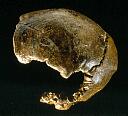It should not be assumed that this site is publicly accessible and it may be on private property. Do not trespass.
Monument details
| HER Number: | TQ 57 SE 219 |
|---|---|
| Type of record: | Monument |
| Name: | The Swanscombe Skull, Barnfield Pit, Swanscombe |
Summary
At Barnfield Pit, a quarry in Swanscombe, three parts of the same skull (The Swanscombe Skull) were found separately in 1935, 1936 and 1955. This is the oldest skull found in Britain. The remains are an ancient form of human called Homo heidelbergensis, dating to around 380,000 years old. In addition to the skull >6000 handaxes, >250 cores, >500 flake-tools and nearly 15,000 pieces of debitage have been found together with a wide range of vertebrate fossils and mollusc remains. (location accurate to the nearest 10m based on available information)
Images

| Grid Reference: | TQ 59760 74300 |
|---|---|
| Map Sheet: | TQ57SE |
| Parish: | SWANSCOMBE AND GREENHITHE, DARTFORD, KENT |
Monument Types
- OCCUPATION SITE (Lower Palaeolithic to Middle Palaeolithic - 500000 BC to 125000 BC)
Associated Finds
- HANDAXE (Lower Palaeolithic - 500000 BC to 150001 BC)
- HUMAN REMAINS (Lower Palaeolithic - 500000 BC to 150001 BC)
Full description
If you do not understand anything on this page please contact us.
The Swanscombe Skull-site NNR is located within Barnfield Pit, Swanscombe which is one of Europe's most important Palaeolithic sites. It is located on a fluvial terrace deposit above the south side of the Thames, originally known as the Swanscombe 100-ft terrace but now formally named the Boyn Hill/Orsett Heath Formation (1). Here, a fossil human skull was recovered from one horizon [The Upper Middle Gravel], with three separate refitting parts of the same skull being found on three separate occasions, in 1935, 1936 and 1955 (2, 3). The area was first recognised as containing artefacts and faunal remains in the late 19th century (4), they have been demonstrated through a long history of subsequent investigations (5-8), to be exceptionally rich in flint tools from Palaeolithic occupation (9, 10). The first investigation to locate the skull was undertaken by A.T Marston, his observations at the south eastern end of the pit. Here he identified the presence of a channel or sump cutting the lower middle gravel which left a series of beaches at its margin, the first of these revealed the fragments of skull. (8)
There are three main phases of deposits at Barnfield Pit. The lowest phase (I) consists of gravels and silts/sands [the "Lower Loam"] with a Clactonian lithic industry (cores, flakes and flake-tools) dating to early in the Hoxnian interglacial. This phase includes undisturbed Clactonian occupation surfaces within, and at the top of, the Lower Loam, as well as animal bones and other paleo-environmental remains such as molluscs and ostracods. The middle phase (II) consists of gravels and sandy gravels. These contain a rich Acheulian lithic industry and numerous fossil animal remains, with numerous fresh condition handaxes and debitage from their manufacture attesting to occupation on the spot. The skull pieces were found within the phase II deposits, at the base of the Upper Middle Gravel. (9)
Further information (10-13)
<1> Bridgland DR, 1994, Quaternary of the Thames., p193-218 (Monograph). SKE32233.
<2> Swanscombe Committee, 1938, Report on the Swanscombe skull: prepared by the Swanscombe Committee of the Royal Anthropological Institute. (Article in serial). SKE32212.
<3> Ovey, C. D., 1964, The Swanscombe Skull: a Survey of Research on a Pleistocene Site (Monograph). SWX9319.
<4> Stopes H,, 1895, A prehistoric metropolis in Kent. (Article in serial). SKE32279.
<5> Smith RA, Dewey H,, 1913, Stratification at Swanscombe: report on excavations made on behalf of the British Museum and H.M. Geological Survey., p 177-204 (Article in serial). SKE32207.
<6> Smith R.A and Dewey H, 1914, The High Terrace of the Thames: report on excavations made on behalf of the British Museum and H.M. Geological Survey., p 187-212 (Article in serial). SKE32181.
<7> Wymer, JJ, 1968, Lower Palaeolithic Archaeology in Britain as represented by the Thames Valley. (Monograph). SKE29697.
<8> Conway BW, McNabb J, & Ashton N, (ed's), 1996, Excavations at Barnfield Pit, Swanscombe, 1968–72. (Monograph). SKE32240.
<9> Wenban-Smith F. F., March 2004, The Stopes Palaeolithic Project: Final Report, site #2 (Unpublished document). SWX12877.
<10> Wenban-Smith FF,, 2009, Henry Stopes (1852-1902): engineer, brewer and anthropologist. (Article in serial). SKE32263.
<11> Wessex Archaeology, 1993, The Southern Rivers Palaeolithic Project, Report No.2: The South West and South of the Thames [Vol. I - text], NWK 4.19 (Monograph). SWX6569.
<12> Essex County Council & Kent County Council, 2003, Archaeological Survey of Mineral Extraction Sites around the Thames Estuary, #911 (Unpublished document). SKE12012.
<13> Wessex Archaeology, March 2004, Swanscombe Heritage Park and Craylands Gorge, Swanscombe, Kent. Archaeological and Geological Desk Based Assessment (Unpublished document). SWX12883.
Sources and further reading
| Cross-ref. | Source description |
|---|---|
| <1> | Monograph: Bridgland DR. 1994. Quaternary of the Thames.. p193-218. |
| <2> | Article in serial: Swanscombe Committee. 1938. Report on the Swanscombe skull: prepared by the Swanscombe Committee of the Royal Anthropological Institute.. Journal of the Royal Anthropological Institute 68, 17-98.. |
| <3> | Monograph: Ovey, C. D.. 1964. The Swanscombe Skull: a Survey of Research on a Pleistocene Site. |
| <4> | Article in serial: Stopes H,. 1895. A prehistoric metropolis in Kent.. Athenaeum 3541 (Sept. 7th): 325.. |
| <5> | Article in serial: Smith RA, Dewey H,. 1913. Stratification at Swanscombe: report on excavations made on behalf of the British Museum and H.M. Geological Survey.. Archaeologia 64: 177-204.. p 177-204. |
| <6> | Article in serial: Smith R.A and Dewey H. 1914. The High Terrace of the Thames: report on excavations made on behalf of the British Museum and H.M. Geological Survey.. Archaeologia 65: 185-212. p 187-212. |
| <7> | Monograph: Wymer, JJ. 1968. Lower Palaeolithic Archaeology in Britain as represented by the Thames Valley.. |
| <8> | Monograph: Conway BW, McNabb J, & Ashton N, (ed's). 1996. Excavations at Barnfield Pit, Swanscombe, 1968–72.. |
| <9> | Unpublished document: Wenban-Smith F. F.. March 2004. The Stopes Palaeolithic Project: Final Report. site #2. |
| <10> | Article in serial: Wenban-Smith FF,. 2009. Henry Stopes (1852-1902): engineer, brewer and anthropologist.. Lithics 30: 65-85. [Great Prehistorians: 150 Years of Palaeolithic Research 1859-2009, RT Hosfield, FF Wenban-Smith, MI Pope (eds)]. |
| <11> | Monograph: Wessex Archaeology. 1993. The Southern Rivers Palaeolithic Project, Report No.2: The South West and South of the Thames [Vol. I - text]. NWK 4.19. |
| <12> | Unpublished document: Essex County Council & Kent County Council. 2003. Archaeological Survey of Mineral Extraction Sites around the Thames Estuary. #911. |
| <13> | Unpublished document: Wessex Archaeology. March 2004. Swanscombe Heritage Park and Craylands Gorge, Swanscombe, Kent. Archaeological and Geological Desk Based Assessment. |
Related records
| TQ 67 SW 1732 | Part of: Palaeolithic land surfaces, working floors, flint findspots and faunal remains uncovered in Barnfield pit. (Monument) |
